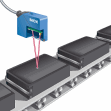Why Choose Us?
- Competitive Prices
- Hands on Support
Sick diffuse sensors
Sick photoelectric sensors with foreground suppression
Photoelectric proximity switches with foreground suppression are able to detect objects within a defined scanning distance. All objects between the scanning distance (set to the background) and the scanner itself are detected above the minimum size. Suppression of the foreground is achieved by means of a special arrangement of sender and receiver elements. To ensure that these sensors can function reliably, the background must be relatively light in colour and not fluctuate.
Sick photoelectric sensors with background suppression
The operating principle of photoelectric proximity sensors with background suppression is based on the geometrical relationship between the sender and receiver elements. The sensor is adjusted to the object located in the scanning plane. Signals from objects which are behind the set scanning plane are supressed. Photoelectric proximity sensors with background supression can be negatively influenced by high-gloss objects in the background, e.g. glass panels, polished metal etc. These effects can increase if the background within the specified scanning distance is not defined. This can be solved by screening off or tilting devices.
Sick photoelectric sensors with background blanking
Background blanking for photoelectric proximity switches is achieved either electronically or optically. In the optical method the angle between the sender and receiver light beam is adjusted while setting the scanning distance to the object. Objects are detected at the point where the emitted beam is reflected back directly to the receiver element. Anything lying below this point remains undetected as no light or too light, reaches the receiver element.
Sick photoelectric sensors, energetic/diffuse
The least expensive solution is the energetic photoelectric proximity sensor with adjustable sensitivity. A light surface reflects more light than a dark surface and can, therefore, be detected from a greater distance. In order to achieve similar results with a dark surface, the sensitivity of the switch must be increased. The detection of a dark object in front of a light background is a problem for energetic sensors. Owing to it’s higher remission, the background “outshines” the object. The sensors are, however, ideal for detecting a light object in front of a dark background.


































Our Social Media Channels